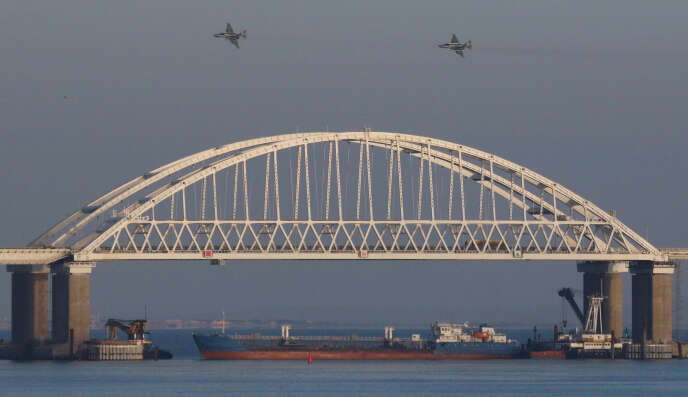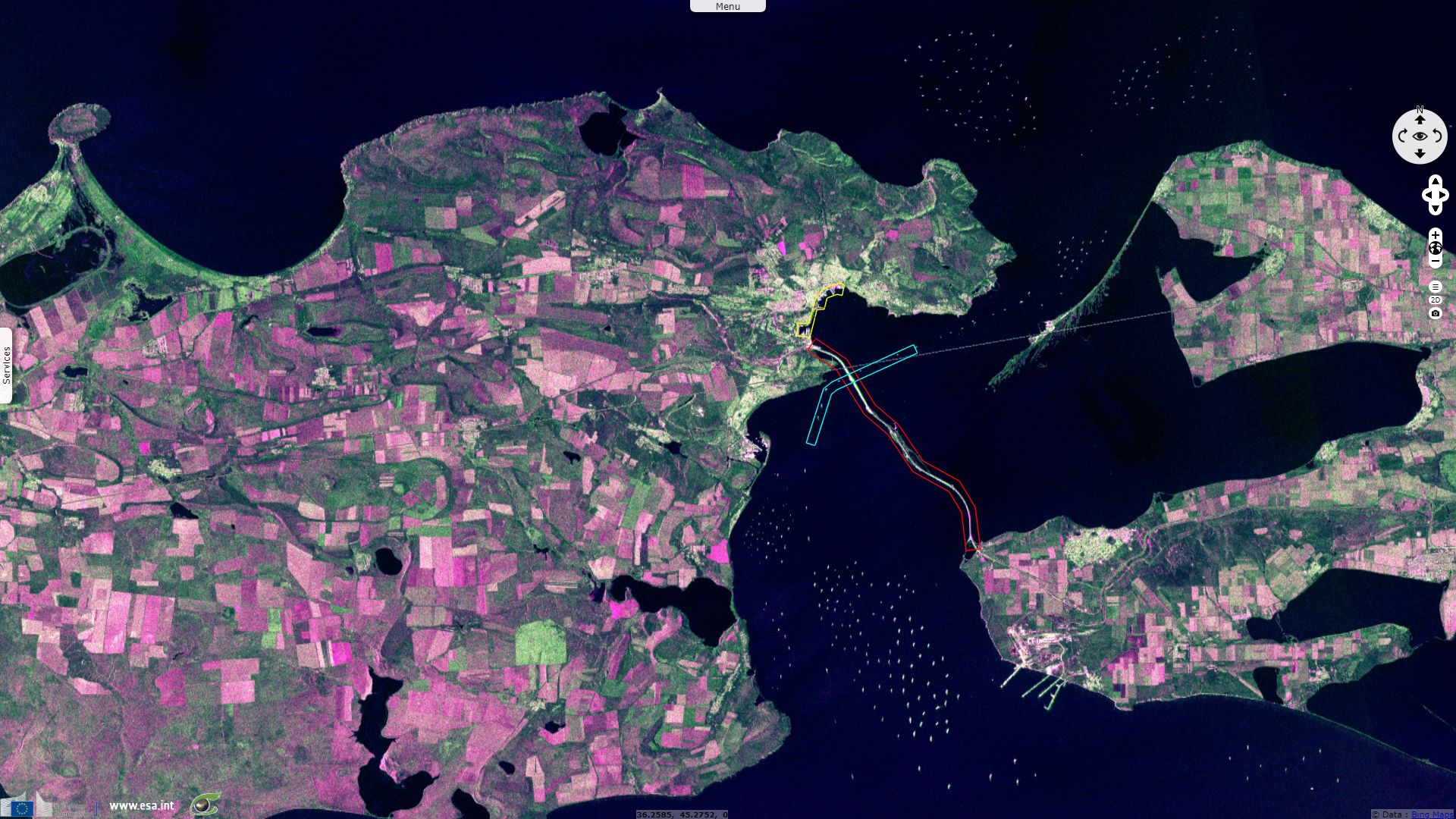Blockade strengthening on Azov sea rises tension
Sentinel-3 OLCI FR acquired on 23 March 2017 from 08:16:55 to 08:19:55 UTC
Sentinel-1 CSAR IW acquired on 21 November 2018 at 15:27:52 UTC
Sentinel-1 CSAR IW acquired on 25 November 2018 from 03:48:24 to 03:48:49 UTC
Sentinel-2 MSI acquired on 25 November 2018 at 08:32:51 UTC
Sentinel-1 CSAR IW acquired on 27 November 2018 from 15:26:59 to 15:27:24 UTC
Sentinel-1 CSAR IW acquired on 21 November 2018 at 15:27:52 UTC
Sentinel-1 CSAR IW acquired on 25 November 2018 from 03:48:24 to 03:48:49 UTC
Sentinel-2 MSI acquired on 25 November 2018 at 08:32:51 UTC
Sentinel-1 CSAR IW acquired on 27 November 2018 from 15:26:59 to 15:27:24 UTC
Keyword(s): Marine traffic, security, port infrastructure, bridge, strait, Ukraine, Russia, Crimea, Sea of Azov, Black Sea.
The Sea of Azov is the shallowest sea in the world, its depth reaches 14m with a 7m mean. There is a constant outflow of water from the Sea of Azov to the Black Sea. The sea is largely affected by the inflow of numerous rivers, which bring sand, silt, and shells, which in turn form numerous bays, limans, and narrow spits. Because of these deposits, the sea bottom is relatively smooth and flat with the depth gradually increasing toward the middle. Also, due to the river inflow, water in the sea has low salinity and a high amount of biomass (such as green algae) that affects the water colour. Abundant plankton results in unusually high fish productivity.
Accessing the Mediterranean Sea from the Sea of Azov necessitates crossing the narrow Kerch Strait to the Black Sea, then crossing the Bosphorus strait to the Sea of Marmara, going through the Dardanelles strait to the Aegean Sea and finally navigating through the Aegean Archipelago. The Sea of Azov is shared by Russia (on its eastern bank) and Ukraine (on its western bank). The Crimea constitutes its south-west bank, it is officially a Ukrainian territory but it has been annexed by Russia in 2014. Since then, Russia controls both banks of the Kerch Strait.
In an article released by Reuters the 25.11.2018, Andrew Osborn & Pavel Polityuk reminded: [Signed in 2003], "a bilateral treaty gives both Russia and Ukraine the right to use the Sea of Azov, which lies between them and is linked by the narrow Kerch Strait to the Black Sea."
In his article published the 12.10.2018 in Le Monde, Benoît Vitkine wrote: Four or five years ago, up to eighteen ships were moored simultaneously on the docks of Mariupol. 90% of Donbass exports, one of the most dynamic regions of Ukraine, passed through this port. Then the war broke out. In the summer of 2014, the Donbass cut in two saw its mines come under the control of the pro-Russian separatists of Donetsk; the railway tracks leading to Mariupol are partly destroyed. Since then, the fighting has never stopped.
Le Monde article further explains the escaladation of the blockade: The Kerch Bridge was inaugurated in May. Its arches forbid the passage to the boats of more than 33 meters high such as Panamax-type ships that represented 20% of the traffic of Kerch Strait but exclusively docked at the two deepwater ports, both Ukrainian. "In the first few weeks, we lost a contract of 1 million tons of cast iron annually exported to the United States," says the director of Mariupol port, "a total of 140 boats lost their shipping contract." Only customers of the Ukrainian ports of Mariupol and Berdyansk, further to the south and specializing in wheat, are affected: those who make the connection with the Russian ports, located in shallower waters, are all below this size.
Benoît Vitkine added in Le Monde: "Former Soviet military navy officer Andriï Klimenko founded in 2010 the specialized information site Black Sea News. In May, Mr. Klimenko noticed on his screens the strange immobility of the boats: the inspections had begun. In July, they lasted an average of 57 hours in the bridge crossing zone towards the Black Sea; in September, 125 hours. At the same time, in the other direction, the checks took about 67 hours. According to his records, this harassment is not limited to the Kerch Strait, where the bridge is built. The approaches to Ukrainian ports are also concerned. An inspection was even made just 3 miles from the coast."
This process is well visible in the figures 4 and 11 as ship pile up and line up.
In his article published in The Guardian the 29.11.2018, Andrew Roth completed: Even before the clash on Sunday [25.11.2018], Moscow had spent months strangling the sea trade into the vulnerable Ukrainian port cities between mainland Russia and Crimea. Now, Kiev has said that several key cities are under an effective sea blockade, with ships trapped at ports such as Mariupol and Berdyansk. “It began this summer, the Russian federation’s answer to us,” said Alexander Barchan, the head of the Berdyansk sea port authority, in an interview at his offices by the docks. Year on year, he said, shipping had already dropped 50%. “I think we can safely call it an economic blockade."
According to Alya Shandra in the news released by the pro-Kiev journal Euromaidanpress: "On 16 September, the Ukrainian government announced its plans to create a naval base in the Azov Sea before the end of the year. A few days later President Petro Poroshenko confirmed the intention in his address to Verkhovna Rada."
"The Ukrainian Military Portal media outlet reported on 23 September that the ships of the Ukrainian Navy, search and rescue vessel A500 “Donbas” and the tug A830 “Korets,” left the Western Naval Base in the Black Sea port of Odesa for Berdiansk on 20 September to found a new Ukrainian naval base in the Sea of Azov."


Ukrainian Navy ships "Donbas" and "Korets" in the Kerch Strain on 23 September, seven sea craft of the Russian escort can be seen in the image - Source: Russian source shared by Ukrainian Military Portal.
Euromaidanpress relates the precise chronology of events: "At 11:00 on 25 November, the Ukrainian ships were told that the Kerch Strait is closed due to a cargo ship being on shore, this information was confirmed by the Spanish traffic controller. However, passage through the strait was in fact not closed, as between 13:40-13:50 EET [UTC+2], the Ukrainian fleet observed one Russian ship and two cutters passing under the Kerch bridge. The Ukrainian ships received no more information and at 17:00 decided to return to the permanent base in Odesa. As the ships left the waiting zone and headed towards Odesa, 40 km to the southeast of Kerch and 13-14 miles from the Crimean coast, the Ukrainian ships were shot at by the Russian ships and connection with them was lost."


Andrew Roth reported in The Guardian the 29.11.2018: On Wednesday [28.11.2018], the Ukrainian minister of infrastructure, Volodymyr Omelyan, wrote that 18 ships, four going to Berdyansk and 14 to Mariupol, were being blocked by Russia from passing through the Kerch strait. Another 17 ships were stuck in the Sea of Azov and could not leave, Omelyan wrote. “Only vessels moving toward Russian ports on the Sea of Azov are permitted entry,” Omelyan wrote. “In essence, Russia has blocked Ukrainian ports on the Sea of Azov.”













